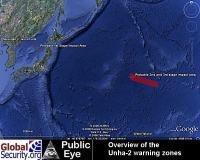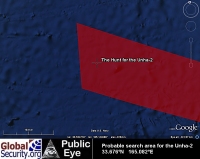It's the stuff of Tom Clancy novels, except it is probably really happening. A US submarine is probably searching the Pacific ocean floor for pieces of an ill-fated North Korean missile. The American people will probably never learn about it in our life time. And the best part is the North Koreans will probably never find out what went wrong with their own rocket.
By Tim Brown
Now that pieces of the second and third stages of the North Korean Unha-2 rocket are laying in about 6,000 meters (or about 19,700 feet) of water, 1,100 nautical miles east of Japan at the bottom of the Pacific Ocean, it is only a matter of time before the SSN-23 Jimmy Carter, launches a submersible remotely-operated vehicle (ROV) to search for pieces of the wreckage. The ROV will image the debris field and may bring the most important bits and pieces back to the US for analysis.
Of course this is only a surmise, but if the United States isn't doing this, it is a shame. We have spent over thee billion dollars of US taxpayer money on a submarine designed to "support classified research, development, test, and evaluation (RDT&E) efforts for tactical undersea surveillance"-- in other words this very kind of clandestine snatch-and-grab operation. If the Carter is unavailable, the fleet of Deep Ocean Survey Vessels certainly could use towed sonar arrays to locate the debris field.
The US deployed assets such as AEGIS frigates and missile tracking aircraft like the RC-135S COBRA BALL on the day of the North Korean rocket launch to track the trajectory and plot the impact area of the ill-fated rocket. Depending on how well they did, the Jimmy Carter may have already found the wreckage and is on its way back to Pearl Harbor or the West Coast.
This mission is akin to a National Transportation Safety Board (NTSB) investigation of an airliner crash, except teams of missile experts from the Missile and Space Intelligence Center at Huntsville, Alabama and the National Air and Space Intelligence Center( NASIC) at Wright Patterson Air Force Base will pour over the wreckage and reassemble the bits and pieces. They will analyze the data and try to answer basic questions, like what went right, what went wrong, and how sophisticated (or primitive) is the North Korean missile technology. Of course this too is pure speculation, but if it has not or will not happen then what are we paying these people to do?
Like the Glomar Explorer that deployed 35 years earlier on Project Jennifer to find the Russian submarine K-129, the Jimmy Carter was built to conduct just this type of clandestine mission. MSIC and NASIC are organized to do just this type of missile analysis. The planning for this above-top-secret-codeword need-to-know project has probably been going on longer than the North Koreans have been preparing for the actual rocket launch. It's the stuff of Tom Clancy novels, except it is probably really happening. Key people in the Defense and Intelligence Community will learn of the results of the research. The President and his national security advisers will be briefed. Maybe Members and staffers on the US Senate Select Committee on Intelligence and the House Permanent Select Committee on Intelligence may eventually get a briefing. The American people will probably never learn about it in our life time.. And the best part is the North Koreans will probably never find out what went wrong with their own rocket.





